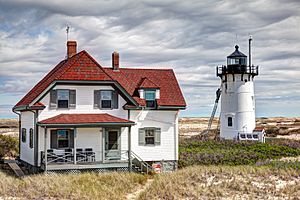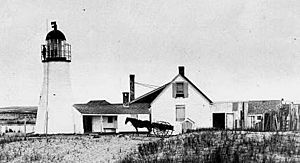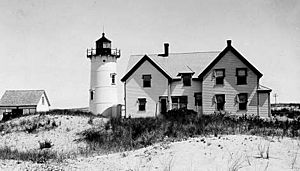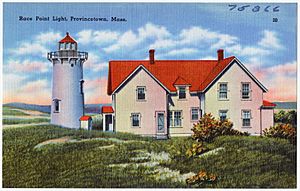Race Point Light facts for kids
 |
|
| The lighthouse gets a fresh coat of paint in 2012 | |
| Location | Cape Cod |
|---|---|
| Coordinates | 42°3′44.4″N 70°14′34.9″W / 42.062333°N 70.243028°W |
| Year first constructed | 1816 |
| Year first lit | 1876 (current structure) |
| Automated | 1972 |
| Foundation | Natural/emplaced |
| Construction | Iron plate with brick interior |
| Tower shape | Conical |
| Markings / pattern | White with black lantern |
| Height | 45 feet (14 m) |
| Focal height | 41 feet (12 m) above mean sea level |
| Original lens | Fourth-order Fresnel lens |
| Current lens | VRB-25 |
| Range | 16 nautical miles (30 km; 18 mi) |
| Characteristic | Fl W 10s |
| Admiralty number | J0386 |
| ARLHS number | USA-680 |
| USCG number | 1-485 |
The Race Point Light is a historic lighthouse located on Cape Cod in Provincetown, Massachusetts. It is a special landmark listed on the National Register of Historic Places. The first lighthouse tower here was lit in 1816. Later, in 1876, a new 45-foot tall iron tower replaced the old one. A new home for the lighthouse keeper was also built at that time.
Today, the American Lighthouse Foundation takes care of the property. They even rent out two of the buildings for people to stay overnight! The actual light that guides ships is maintained by the Coast Guard. You can reach the lighthouse by walking about 45 minutes across the sand. If you have a special permit from the National Park Service, you can also use a four-wheel-drive vehicle to get there.
History of Race Point Light
Race Point Light was first built in 1816. It was the third lighthouse on Cape Cod. Before it, Highland Light was built in 1797 and Chatham Light in 1808. The first Race Point Light was a 25-foot tower made of rough stones. It was one of the first lighthouses to have a light that spun around. This spinning light helped sailors tell it apart from other lighthouses on Cape Cod.
In 1858, the lighthouse got a new, improved light called a fourth-order Fresnel lens. This special lens made the light much brighter and easier to see. A second house for the lighthouse keepers was added in 1874.
By 1876, the original stone tower was getting old and worn out. So, it was replaced with the 45-foot tall tower you see today. This new tower was made of cast iron plates and lined with bricks. The bright Fresnel lens was moved into the new tower. The old stone house for the keeper was also removed and replaced with a wooden one.
The lighthouse became electric in 1957. The larger keeper's house was taken away in 1960, and the other one was updated. In 1972, the light was made "automated." This means it could work by itself without a keeper needing to be there all the time.
In 1995, the American Lighthouse Foundation updated the keeper's house. They started letting people stay overnight in 1998. A solar power system was put in place in 2003. A wind turbine was added in 2007 to help power the light. The light now uses a solar-powered VRB-25 optic, which is very bright. The Coast Guard still operates the light itself.
You can take tours of the site on the first and third Saturdays from June to October. Both the Keeper's House and the Whistle House are available for people to rent for overnight stays.
Race Point Light was added to the National Register of Historic Places on June 15, 1987. It is listed as the Race Point Light Station.
Lighthouse Keepers at Race Point
Many people worked as lighthouse keepers at Race Point Light over the years. Some stayed for a long time, while others were there for only a short period. Some keepers started as assistants before becoming the main keeper. Here is a list of some of the people who kept the light shining:
- Joshua Dyer (1816 – 1822)
- Elijah Dyer (1822 – 1847)
- Lemuel Cook (1847 – 1853)
- Waterman Crocker (1853 – 1861)
- Josiah Ghenn (1861 – 1870)
- James Cushman (1870 – 1885)
- Thomas V. Mullins (1885 – 1892)
- Charles A. Havender (1892 – 1904)
- Samuel S. Smith (1904 – 1909)
- Roscoe G. Lopaus (1909)
- Waldo Leighton (1909 – 1915)
- William H. Lowther (1915 – 1935)
- James W. Hinckley (1935 – 1937)
- Javan D. York (1938 – 1942)
- Theodore M. Koswoski (1944)
- James O’Brien (1944)
- Joseph L. Collette (1944)
- Osborne E. Hallett (1945 – 1955)
- Elias J. Martinez (1955 – 1956)
- Gottfried Schiffers (1956 – 1958)
- Elias J. Martinez (1958 – 1959)
- Aubrey T. Griggs (1959 – 1960)




